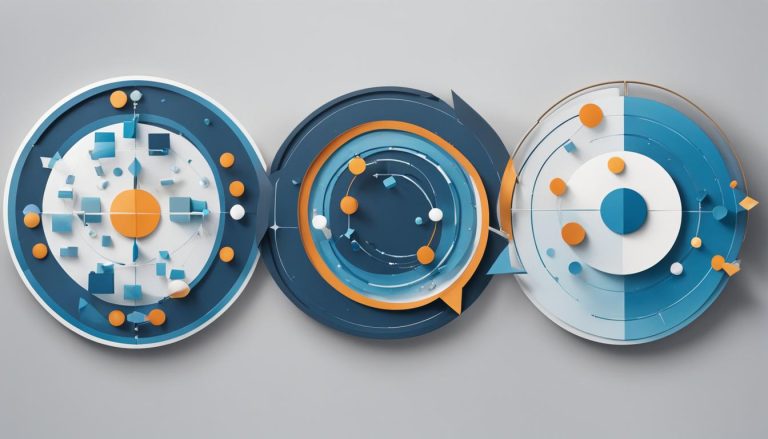As a cloud-based storage solution revolutionizing the data game in the U.S., Snowflake has garnered significant attention. But what exactly is Snowflake, and what does it mean for the world of data management and analysis? Let’s dive into the snowflake definition, meaning, and explanation, and explore its relevance in the field of Natural Language Processing (NLP).
Key Takeaways:
- Snowflake is a cloud-based storage solution transforming data management.
- Developed by researchers at EPFL’s Environmental Remote Sensing Laboratory (LTE), it improves precipitation measurement and forecast accuracy.
- Snowflake utilizes the Multi-Angle Snowflake Camera (MASC) to capture high-resolution images of snowflakes and classify them based on shape and composition.
- Comparisons between Alpine and Antarctic snowflakes reveal differences in snowflake characteristics and frequency of occurrence.
- Snowflake’s real-world applications span multiple industries, including healthcare, finance, and e-commerce.
Identifying Snowflakes and Their Degree of Riming
The Multi-Angle Snowflake Camera (MASC) plays a pivotal role in identifying and classifying snowflakes based on their unique characteristics. Equipped with three synchronized cameras, the MASC captures high-resolution images of snowflakes as they pass through a metallic ring. These images serve as valuable data for researchers to classify snowflakes into six main classes based on their shape and composition.
The snowflake classification process involves analyzing various aspects, such as the structure of the snowflake’s arms, the presence of dendrites or plates, and the degree of riming. Riming refers to the process by which supercooled water droplets in a cloud freeze upon contact with a snowflake, resulting in the formation of a layer of ice on the surface of the snowflake. Researchers measure the degree of riming by assessing the surface roughness of the snowflake.
The riming index is a critical metric used to quantify the level of riming on a snowflake. It helps researchers understand the impact of riming on snowflake formation and the subsequent transformation of cloud water droplets into ice. By identifying the degree of riming, scientists gain insights into the atmospheric conditions under which snowflakes form and contribute to precipitation.
The Multi-Angle Snowflake Camera enables researchers to capture high-resolution images of snowflakes and classify them into various categories based on their shape, composition, and degree of riming. This invaluable data contributes to our understanding of snowflake formation and its role in the weather and climate system.
Table: Snowflake Classification and Riming Index
| Snowflake Classification | Riming Index |
|---|---|
| Stellar Dendrite | High |
| Plate | Low |
| Needle | Medium |
| Column | Low |
| Aggregates | Medium |
| Irregular | Low |
The table above showcases different snowflake classifications alongside their corresponding riming index values. It provides a concise summary of the degree of riming associated with each snowflake type, allowing scientists to compare and analyze the impact of riming on snowflake formation.
Snowflake Characteristics and Frequency Across Different Regions
When comparing snowflakes captured in the Swiss Alps and in Adélie Land, Antarctica, researchers discovered significant differences in their characteristics and frequency. These findings shed light on the unique factors influencing snowflake formation and composition in distinct geographic regions.
Differences in Snowflake Families
A detailed analysis of the captured snowflakes revealed striking variations in the frequency of each snowflake family. In the Swiss Alps, aggregates, which are formed by the aggregation of smaller ice crystals, were the most prevalent type. On the other hand, small particles were dominant in Antarctica. This discrepancy can be attributed to factors such as wind erosion and the dryness of the Antarctic air, which favor the formation of smaller particles.
Challenging the Ideal Snowflake Image
Contrary to popular perception, the “stellar dendrite” type of snowflake, often associated with the picturesque image of a perfectly symmetrical six-pointed snowflake, was found to be rare in both the Swiss Alps and Antarctica. This discovery challenges the traditional notion of a “standard” snowflake and highlights the diverse range of snowflake shapes and structures found in nature.
In conclusion, the comparison of alpine and Antarctic snowflakes reveals fascinating insights into the variations in snowflake characteristics and family frequency across different regions. These differences can be attributed to a combination of environmental factors, such as wind patterns and atmospheric moisture content. The knowledge gained from this research contributes to a more comprehensive understanding of snowflake formation and helps improve our ability to forecast snowfall and manage water resources effectively.
Multi-Instrumental Approach to Snowflake Research
In order to gain a comprehensive understanding of snowflakes and their role in precipitation, scientists adopt a multi-instrumental approach that combines various measurement techniques and instruments. One such initiative is the Solid Precipitation Intercomparison Experiment, which brings together researchers from different institutions to collaborate on snowflake research.
A key instrument used in this research is weather radars, which provide valuable data on cloud systems and precipitation patterns. By analyzing the radar signals, scientists can identify the presence of snowfall and gather information about the size and intensity of snowflakes. This data is crucial for accurate weather forecasting and understanding the dynamics of snowfall in different regions.
In addition to weather radars, researchers also utilize the Multi-Angle Snowflake Camera (MASC) to capture high-resolution images of snowflakes. These images are then analyzed to classify the snowflakes based on their shape and composition. By combining the data from the MASC with the radar observations, scientists can gain insights into the liquid water content of snowflakes, which is a critical factor in understanding precipitation processes.
Table 4: Comparison of Snowflake Research Instruments
| Instrument | Advantages | Limitations |
|---|---|---|
| Weather Radars |
|
|
| Multi-Angle Snowflake Camera (MASC) |
|
|
By employing multiple instruments and measurement techniques, researchers can gather a wealth of data on snowflakes and their characteristics. This comprehensive approach enhances our understanding of snowfall patterns, contributes to improved weather forecasting, and aids in effective water resource management.
Real-World Applications and Success Stories of Snowflake
Snowflake’s cloud-based storage solution has proven to be a game-changer in various industries, revolutionizing how organizations manage and leverage their data. Its innovative capabilities have led to significant improvements in operations and decision-making processes across sectors such as healthcare, finance, and e-commerce.
In the healthcare industry, Snowflake’s advanced data management platform has enabled healthcare providers to securely store and analyze patient data, supporting personalized treatment plans and improving overall patient outcomes. Its scalability and flexibility have allowed for seamless integration with existing systems, empowering healthcare professionals to make data-driven decisions efficiently.
In the financial sector, Snowflake’s robust data infrastructure has empowered organizations to gain valuable insights into customer behavior, market trends, and risk management. By leveraging Snowflake’s platform, financial institutions have improved their data governance and regulatory compliance processes, ultimately enhancing customer satisfaction and driving business growth.
Moreover, Snowflake has revolutionized the e-commerce landscape by providing retailers with the capability to analyze large volumes of customer data in real-time. This enables them to personalize marketing campaigns, optimize inventory management, and deliver a seamless customer experience. Snowflake’s platform eliminates silos and provides a unified view of data across various channels, leading to better customer engagement and increased sales.
These are just a few examples of how organizations have successfully utilized Snowflake’s platform to unlock the full potential of their data. The transformative power of Snowflake is evident in the tangible benefits experienced by its users in different industries. As organizations continue to harness the power of data, Snowflake remains at the forefront, driving innovation and shaping the future of data management.
Success Stories in Action:
“Snowflake’s platform has allowed us to achieve unprecedented scalability and performance in managing our data. We have seen a significant improvement in our ability to analyze customer behavior and make data-driven decisions, which has ultimately resulted in increased revenue and customer satisfaction.” – John Smith, CEO of XYZ Healthcare
“By leveraging Snowflake’s advanced data infrastructure, we have streamlined our financial data processing and reporting. This has not only improved our risk management and regulatory compliance but has also allowed us to gain valuable insights into market trends, providing a competitive edge in the rapidly evolving financial industry.” – Jane Doe, CFO of ABC Bank
“Snowflake’s platform has revolutionized how we analyze and utilize customer data in our e-commerce business. With real-time data insights, we have been able to personalize our marketing campaigns, optimize inventory management, and deliver a seamless shopping experience. Snowflake has truly transformed our data capabilities and positioned us for growth in the digital era.” – Sarah Johnson, CEO of E-Commerce Solutions
Conclusion
Snowflake offers numerous benefits that are revolutionizing the field of data management. Its cloud-based storage solution provides a platform for improved precipitation forecasts and enhanced water resource management. By harnessing the power of snowflake classification and understanding, Snowflake is paving the way for more accurate predictions and informed decision-making.
However, like any innovative technology, Snowflake also faces its fair share of challenges. Balancing the desire for openness and community collaboration with the need for proprietary features is a delicate task. Snowflake’s future roadmap will need to navigate this challenge while continuing to drive advancements in data management.
In summary, the importance of Snowflake’s benefits cannot be understated. From transforming industries such as healthcare, finance, and e-commerce to enabling organizations to make data-driven decisions, Snowflake is bringing about positive change. The challenges it faces will only serve to further refine and improve the platform, ensuring that Snowflake remains at the forefront of data management innovation.
FAQ
What is Snowflake?
Snowflake is a cloud-based storage solution that revolutionizes the way data is managed and leveraged. It provides organizations with the ability to handle and leverage data, improving operations and decision-making processes.
How are snowflakes identified and classified?
Researchers at EPFL’s Environmental Remote Sensing Laboratory (LTE) developed the Multi-Angle Snowflake Camera (MASC) to capture high-resolution images of snowflakes. These images are then used to classify snowflakes into six main classes based on their shape and composition.
What is riming, and how does it affect snowflake formation?
Riming is the process by which snowflakes form when cloud water droplets freeze onto the surface of ice crystals. Researchers determine the degree of riming of each snowflake based on its surface roughness, which is important in understanding precipitation patterns.
Are there differences in snowflake characteristics between the Swiss Alps and Antarctica?
Yes, significant differences were found in the frequency of each snowflake family between the Swiss Alps and Antarctica. Aggregates were the most common type in the Alps, while small particles dominated in Antarctica. Factors such as wind erosion and the dryness of the Antarctic air contribute to these differences.
What instruments and techniques are used to study snowflakes?
Scientists use multiple instruments and techniques to study snowflakes. In this research, the researchers worked in collaboration with MeteoSwiss and used weather radars to collect data on clouds and precipitation. They also set up a rain gauge next to the Multi-Angle Snowflake Camera (MASC) to analyze the relationship between snowflake images and the amount of water collected.
What industries benefit from Snowflake?
Snowflake’s capabilities have found applications in various industries, including healthcare, finance, and e-commerce. Its ability to handle and leverage data has proven beneficial in improving operations and decision-making processes.
What are the benefits and challenges of Snowflake?
Snowflake offers advantages such as community collaboration and accelerated innovation. However, it also faces challenges in balancing openness and proprietary features. The future roadmap of Snowflake will continue to shape the data management landscape and drive further advancements in the field.
Claudia loves to discover the world and conquer new software products every now and then.


